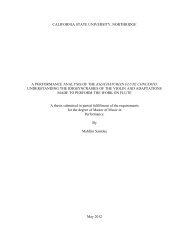2644 - CSUN ScholarWorks - California State University, Northridge
2644 - CSUN ScholarWorks - California State University, Northridge
2644 - CSUN ScholarWorks - California State University, Northridge
Create successful ePaper yourself
Turn your PDF publications into a flip-book with our unique Google optimized e-Paper software.
62 · Journal of Student Research Abstracts<br />
2778<br />
THE EFFECTS OF CARROT JUICE ON E. COLI BACTERIA.<br />
Stanley Wong and Stephen DeGusta (teacher). John F. Kennedy High School, 6715 Gloria Drive,<br />
Sacramento, CA 95831.<br />
The purpose of this experiment was to test if carrot juice can be a growth inhibitor for a non-pathogenic<br />
strain Escherichia coli. Carrots contain complex sugars which interferes with the binding of pathogenic bacteria<br />
to the intestinal lining. Carrots have been used for centuries in the treatment and prevention of diarrhea.<br />
Pathogenic strains of E. coli have been known to cause severe diarrhea. Non-pathogenic strains of E. coli aids<br />
the intestines in digestion. In my experiment, 1 isolated carrot juice in filter disks and placed these disks into<br />
a nutrient agar media containing E. coli. I attempted to see if there were any difference between the disks containing<br />
the carrot juice and the control, disks containing ordinary filter paper. To my surprise, the carrot juice<br />
seems to aid the growth of non-pathogenic E. coli although it affects the binding of pathogenic E. coli to the<br />
intestinal lining. When observing the dishes, I found more colonies of E. coli surrounding the disks containing<br />
the carrot juice than the control. This method of testing led me to conclude that carrot juice not only aids<br />
treating pathogenic bacteria in the intestines, but also encourages the growth of non-pathogenic E. coli.<br />
2779<br />
VARIANCE OF ROOTS GROWN IN DIFFERENT FIELD CAPACITIES.<br />
Lisa Ann Gregory, Steve DeGusta (teacher). John F. Kennedy High School, 6715 Gloria Drive, Sacramento,<br />
CA 95813.<br />
The primary purpose of this experiment was to see if the field capacity of a soil has a direct effect on the<br />
root growth of bean plants. The field capacity is defined as the ability of a soil to retain water (Schultz, 1960).<br />
The conditions set to test my problem were to grow 10 bean plants in potting soil and 10 bean plants in sand.<br />
I chose these soils I because potting soil has an almost four times higher field capacity than sand (Gregory,<br />
1998). Both groups were given the same amount of water over a period of 11 days. After four days I didn't<br />
water the plants for three days so that the plants would have to survive on the water retained by the soils.<br />
After 11 days I took the plants out of their pots and measured the lengths of the primary roots of each plant,<br />
their heights, and counted the number of roots of each plant. The mean of the lengths of the primary roots of<br />
each plant grown in potting soil was 13.8 em, and for the plants grown in sand was 5.3 em. The mean of the<br />
heights of the bean plants grown in potting soil was 7.85 em, and in sand was 3.86 em. The mean of the number<br />
of roots of each plant grown in potting soil was 39, and in sand was 18.7.<br />
I conclude that the bean plants grown in potting soil adapted much better to their environment than those<br />
grown in sand. This was due to the lack of water due to the low field capacity of sand. Also, sand is inoraganic<br />
so nutrients were scarce to those bean plants. The bean plants grown in potting soil were taller (p













